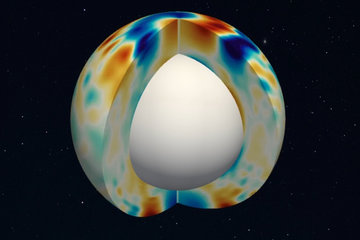All genres
141.
Journal Article
Bi-directional plasma jets produced by magnetic reconnection on the Sun. Nature 386, pp. 811 - 813 (1997)
142.
Journal Article
SUMER observations of the quiet solar atmosphere: The network chromosphere and lower transition region. Astrophysical Journal 490, pp. L195 - L198 (1997)
143.
Journal Article
Electron density diagnostics for the solar upper atmosphere from spectra obtained by SUMER/SOHO. Astrophysical Journal 485, pp. 911 - 919 (1997)
144.
Journal Article
First results of the SUMER telescope and spectrometer on SOHO: II. Imagery and data management. Solar Physics 170, pp. 105 - 122 (1997)
145.
Journal Article
High resolution solar ultraviolet measurements. Advances in Space Research 20, pp. 2249 - 2258 (1997)
146.
Journal Article
Turbulent velocities and ion temperatures in the solar corona obtained from SUMER line widths. Astrophysical Journal 484, pp. L87 - L90 (1997)
147.
Journal Article
Observations of Doppler shifts in a solar polar coronal hole. Astrophysical Journal 490, pp. L187 - L190 (1997)
148.
Journal Article
Doppler shifts and nonthermal broadening in the quiet solar transition region: O VI. Astrophysical Journal 484, pp. L91 - L94 (1997)
149.
Journal Article
First results of the SUMER telescope and spectrometer-solar ultraviolet measurements of emitted radiation-on SOHO, I. Spectra and Spectroradiometry. Solar Physics 170, pp. 75 - 104 (1997)
150.
Journal Article
Radiometric calibration of SUMER: Refinement of the laboratory results under operational conditions on SOHO. Applied Optics 36, pp. 6416 - 6422 (1997)
151.
Journal Article
Radiometric calibration of the telescope and ultraviolet spectrometer SUMER on SOHO. Applied Optics 35, pp. 5125 - 5133 (1996)
152.
Journal Article
Beobachtungen der Sonne mit den Methoden der Weltraumforschung. Sterne und Weltraum 12, pp. 900 - 902 (1995)
153.
Journal Article
SUMER-Solar ultraviolet measurements of emitted radiation. Solar Physics 162, pp. 189 - 231 (1995)
154.
Journal Article
Study of the quiet corona with the SOHO/SUMER spectrometer. Advances in Space Research 14, pp. (4)171 - (4)174 (1994)
155.
Journal Article
Observations of antarctic auroral electron precipitation with high stability in time and longitude. Annales Geophysicae 9, pp. 259 - 266 (1991)
156.
Journal Article
Position of comet P/Halley at the Giotto encounter. Astronomy and Astrophysics 191, pp. 1 - 3 (1988)
157.
Journal Article
Observations of low-latitude electron precipitation. Journal Geophysical Research 93, pp. 4131 - 4133 (1988)
158.
Journal Article
Comet P/Halley's nucleus and its activity. Astronomy and Astrophysics 187, pp. 807 - 823 (1987)
159.
Journal Article
The Halley multicolour camera. J. Phys. E: Sci. Instrum. 20, pp. 807 - 820 (1987)
160.
Journal Article
Detailed analysis of a surface feature on comet P/Halley. Astronomy and Astrophysics 187, pp. 847 - 851 (1987)











